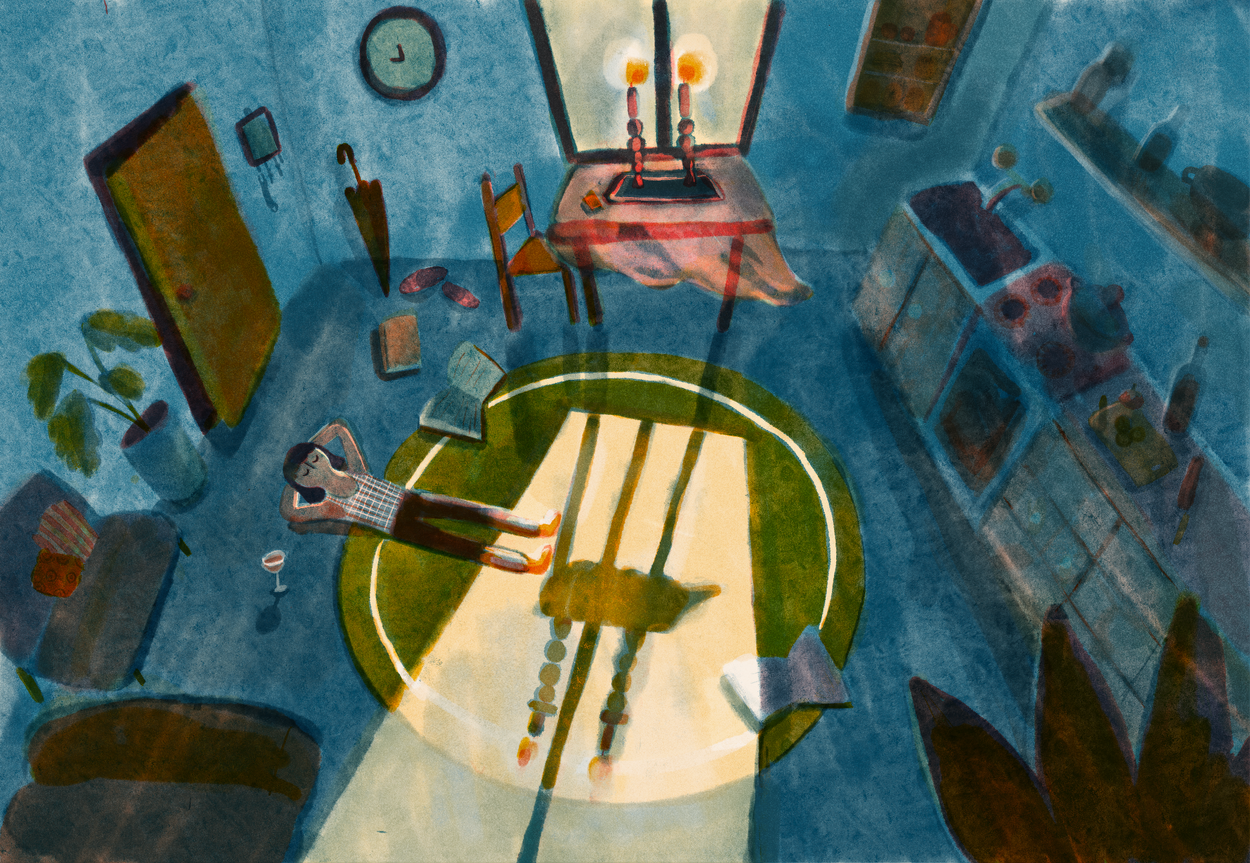Issue 9: Rituals
Disconnect to Reconnect

Written by Dalit Shalom
Illustration by Shira Seri Levi

Every Friday my day starts on a high as I anticipate the transition at sunset into a moment of serenity—Shabbat.
Shabbat is a concept that many are familiar with. In American culture it’s widely known as the Sabbath, and is practiced in several variations around the world. Originating in Jewish tradition but not exclusive to the Jewish faith, Shabbat is known to be a day of rest, recharge, and reflection.
The idea of Shabbat is first seen in the beginning of the Torah: after the creation of the world over the course of six days, and after the last creation of man and woman, a seventh day was reserved exclusively for rest. The cyclical rhythm of a week concluding in a day of rest can be seen as a cornerstone of Jewish tradition throughout history. On Shabbat, Jews make a deliberate choice to halt their weekly work and intentionally make space to disconnect and rest. Over time, this practice has been adopted by other religions, as well as individuals in modern times, and has been re-interpreted to reflect what it means to “rest” today. Observing Shabbat today may include a full disconnect from electronics and technology, with gatherings at synagogues with friends and family, but many people have a practice of honoring a “digital Shabbat” by turning their personal devices off and letting go of the obligations associated with digital communication.
Why, you may ask, is it necessary to have an organized day of rest? Can’t one decide for oneself when they are in need of space and pause, and just create it “on demand”?
Over the years, I have learned that the answer is simply, no.
As overachieving humans, we’ve trained ourselves to cultivate gratification and satisfaction from experiences and interactions that don’t allow us to enter into a complete state of rest. In fact, most of the time those interactions and experiences demand the exact opposite. They require our full attention, they often compromise our mental and physical well being, and maybe most troubling of all—they leave a lingering aura of anxiety that bleeds into any void in the mind. For example, if I’ve been emailing with a friend or a colleague, and for whatever reason I haven’t yet replied to their last email, that seemingly micro- task often stays pulsing in my mind: a dissonance, something is not yet completed, until it’s been resolved. Many of these micro-tasks collectively create an avalanche of anxiety that can seem to have no end, and leave us in an illusion of failure, debt and critique.
Shabbat is a time each week where I am able to give myself permission to step away from these cultural norms that have formed over the years in our highly stimulated and tech-savvy lives. What may appear to be a “disconnect” for many, for me it is actually a reconnection to myself. I spend Shabbat, either as host or guest, a gathering of friends and family, engaging in meaningful conversation with them, and maybe most importantly, nurturing a practice that reminds me to put my well-being in front of any sort of social norm that suggests otherwise.
Even though Shabbat is a ritual rooted in my Jewish tradition and heritage, I believe Shabbat can be a practice for everyone. It’s always been a set routine in my life, which is not to say it’s always a perfect utopia—the worries of the week can and do find their way into the serenity of Shabbat from time to time. But as an ideal and as a model, Shabbat has helped me create healthy boundaries on many fronts. If this idea appeals to you I invite you to explore what your version of Shabbat, rest, and reflection might look like. Close your eyes and imagine, What does rest look like for me? It is my wish that if you seek pause and intentional moments of calm, you can declare them and take pride in the peace of mind that we have learned over the past two years we all deserve. Shabbat Shalom.
About the Author
DalitShalom (@dashalom)is a lead designer at The New York Times where she creates new formats, spaces and tools that advance storytelling. Her work consists of research, ideation and prototyping, as well as a great deal of listening and critical thinking. Dalit believes in design as a vehicle for advancing conversation and debate, and is passionate about designing content and products that help people understand the world better. She holds a BDes from Bezalel Academy of Art and Design in Jerusalem, and a Masters degree from the Interactive Telecommunications Program at NYU. Dalit teaches design thinking classes at NYU and Columbia University. In her free time she enjoys baking patisserie desserts and making chocolate from scratch.
